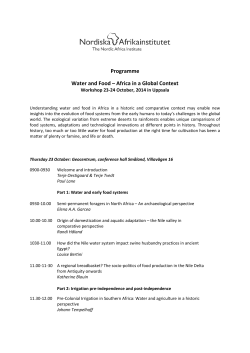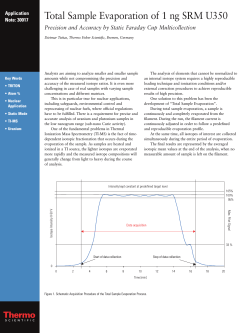
Case Studies: Planning and Adaptation
American Water Resources Association 2015 SUMMER SPECIALTY CONFERENCE Climate Change Adaptation June 15 ‐ 17, 2015 New Orleans, LA Tuesday, June 16 1:30 PM – 3:00 PM SESSION 10: Case Studies: Planning and Adaptation Climate Adaptation Planning Across a Multi‐Jurisdictional Watershed: the Common Waters Case Study ‐ Stephanie Dalke, Pinchot Institute for Conservation, Washington, DC (co‐author: S. Beecher) Translating scientific information about climate change into meaningful actions on the ground is a challenge that many natural resource and local government professionals are facing right now. In the Delaware River basin, the Common Waters Partnership recognized this challenge and has taken the first steps to integrate climate adaptation into decisions across the upper portion of the basin. Common Waters is a regional partnership of public and non‐profit organizations and agencies created to conserve clean water, natural places, and working lands through cooperation, scientific research, education, and technical assistance. The partnership strives to facilitate information sharing across municipal, county, and state boundaries via regular forums and cooperative projects. The Common Waters Partnership's mission is perfect for helping local decision makers take steps to improve the resiliency of their communities and their natural resources to climate change impacts. To this end, the Model Forest Policy Program (MFPP), the Cumberland River Compact, Headwaters Economics, the Common Waters Partnership and the Pinchot Institute for Conservation came together in 2013 to create a climate adaptation plan for communities of the Upper Delaware River Region. Development of the plan came about because all parties, led by MFPP, recognized the critical need for local community resilience against the impacts of climate change by protecting forest and water resources. This climate adaptation plan for southeastern New York, northeastern Pennsylvania and northwestern New Jersey presents the results of a community team effort, deep and broad information gathering, critical analysis and thoughtful planning. The Common Waters Partnership and Pinchot Institute for Conservation shared the local leadership role to engage with the Climate Solutions University: Forest and Water Strategies program (CSU) and lead their community toward climate resilience with an adaptation plan that addresses their local climate risks and fits their local conditions and culture. The goal of CSU, created by MFPP, is to empower rural, underserved communities to become leaders in climate resilience using a cost effective distance‐learning program. The result of this collaborative effort is a powerful climate adaptation plan that bridges the gap between scientific information and local decisions. Common Waters is now working to support and implement the plan, and lessons learned so far will be shared. The ultimate goal of these efforts is a region that can better withstand impacts of climate upon its natural resources, economy, and social structure in the decades to come. Because the Delaware Basin is heavily populated and a significant source of water for drinking and electricity production, it will be critical to successfully implement watershed‐focused climate adaptation strategies over the coming years. Projected Yield Reductions of Dallas Water Utility Reservoirs from Climate Change ‐ Zachary Stein, HDR, Austin, TX (co‐authors: C. Braneon, C. Shockley, D. Qualls)) Climate change is expected to lead to an increase in surface air temperatures in Northeast Texas and many other regions of the world during the 21st century (Intergovernmental Panel on Climate Change (IPCC), 2007; Jiang and Yang, 2012). Climate models predict an increase in average high temperature of 2° Fahrenheit (°F) from historical average high temperatures by 2020 and a 7°F increase from historical average high temperatures by 2070 for Northeast Texas. This increase in temperature will lead to an increase in reservoir evaporation. The increased evaporation will reduce reservoir yields and consequently reduce surface water availability. Thus, an estimate of projected reservoir evaporation considering climate change is critical to projecting future reservoir yields. As part of ongoing water supply planning work for Dallas Water Utilities, regression equations were developed by HDR that describe the relationship between cumulative estimated gross pan evaporation and monthly average daily maximum temperature. These regression equations are utilized along with projections of increased daily maximum temperature derived from eight global climate models (also known as general circulation models, GCMs) in order to estimate an average evaporation rate increase for selected decadal points in the planning horizon (2020 and 2070). Dallas' reservoirs were simulated using historical inflows and precipitation along with the projected increases in evaporation from historical values to calculate reductions in firm yield supply as a result of climate change. Results of the model simulations revealed that firm yield reductions from increased evaporation were up to three times greater than the amount of reduction estimated to occur from sediment accumulation by the year 2070. This additional reduction in firm yield supply will cause water suppliers to alter their current water supply planning schedule in order to bring new supply sources online earlier to meet previously unforeseen deficits resulting from climate change. In summary, HDR would like the opportunity to present additional information on the following topics associated with the analysis: GCMs and downscaling approach; Evaporation estimation methods; Development of projected increases in temperature due to climate change; and Summary of findings from analysis Designing a Climate Change Data Service for Local Planners – Robert Cheetham, Azavea, Philadelphia, PA Every five years, the Intergovernmental Panel on Climate Change releases dozens of new models that include 100 years of climate forecasts based on different emissions scenarios. Concurrently, several reports are released that describe the dire consequences if action is not taken. But while the resulting news media stories are frightening, for most of us, the data is abstract, and few of us are in a position to act on a global basis, and it’s not clear what, if anything, we should do based on these forecasts. Some cities have appointed resiliency officers and developed sustainability programs. Some have hired consultants to prepare reports that help them interpret the data. These are all helpful and proactive steps, but most local municipalities can’t afford to have dedicated staff or hire consultants. In 2014, Azavea received a Small Business Innovation Research (SBIR) grant from the US Department of Energy to create new software and data services that can make the global forecasting models more relevant at the local and regional levels. The initial phase of the research has been focused on two areas: distributed data processing and user interface design. The IPCC climate forecast data sets, even at coarse spatial resolution, are several terabytes, and the size grows rapidly with downsampling. We want to support computation of locally relevant climate impact metrics at near real‐time speed. Second, we believed that good user interface and user experience design would be key to enabling use of the forecast data by local planners. Since last summer, we have developed a prototype climate impact data service, and we are about to embark on the second phase. This talk will review the results of the first phase of our research, including the design and development process by which the prototype was created as well as outline some of the next steps.
© Copyright 2025
















